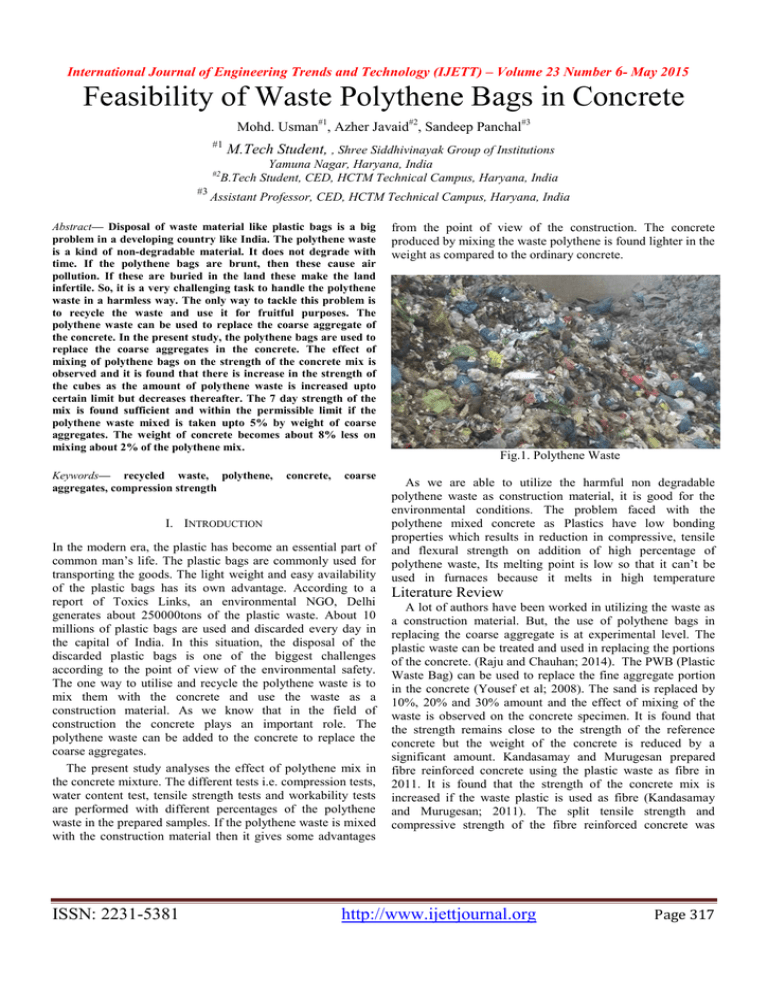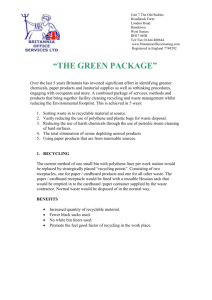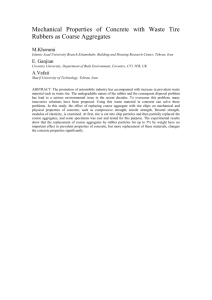Feasibility of Waste Polythene Bags in Concrete 6 M.Tech Student,
advertisement

International Journal of Engineering Trends and Technology (IJETT) – Volume 23 Number 6- May 2015 Feasibility of Waste Polythene Bags in Concrete Mohd. Usman#1, Azher Javaid#2, Sandeep Panchal#3 #1 M.Tech Student, , Shree Siddhivinayak Group of Institutions Yamuna Nagar, Haryana, India B.Tech Student, CED, HCTM Technical Campus, Haryana, India #2 #3 Assistant Professor, CED, HCTM Technical Campus, Haryana, India Abstract— Disposal of waste material like plastic bags is a big problem in a developing country like India. The polythene waste is a kind of non-degradable material. It does not degrade with time. If the polythene bags are brunt, then these cause air pollution. If these are buried in the land these make the land infertile. So, it is a very challenging task to handle the polythene waste in a harmless way. The only way to tackle this problem is to recycle the waste and use it for fruitful purposes. The polythene waste can be used to replace the coarse aggregate of the concrete. In the present study, the polythene bags are used to replace the coarse aggregates in the concrete. The effect of mixing of polythene bags on the strength of the concrete mix is observed and it is found that there is increase in the strength of the cubes as the amount of polythene waste is increased upto certain limit but decreases thereafter. The 7 day strength of the mix is found sufficient and within the permissible limit if the polythene waste mixed is taken upto 5% by weight of coarse aggregates. The weight of concrete becomes about 8% less on mixing about 2% of the polythene mix. Keywords— recycled waste, polythene, aggregates, compression strength concrete, coarse I. INTRODUCTION In the modern era, the plastic has become an essential part of common man’s life. The plastic bags are commonly used for transporting the goods. The light weight and easy availability of the plastic bags has its own advantage. According to a report of Toxics Links, an environmental NGO, Delhi generates about 250000tons of the plastic waste. About 10 millions of plastic bags are used and discarded every day in the capital of India. In this situation, the disposal of the discarded plastic bags is one of the biggest challenges according to the point of view of the environmental safety. The one way to utilise and recycle the polythene waste is to mix them with the concrete and use the waste as a construction material. As we know that in the field of construction the concrete plays an important role. The polythene waste can be added to the concrete to replace the coarse aggregates. The present study analyses the effect of polythene mix in the concrete mixture. The different tests i.e. compression tests, water content test, tensile strength tests and workability tests are performed with different percentages of the polythene waste in the prepared samples. If the polythene waste is mixed with the construction material then it gives some advantages ISSN: 2231-5381 from the point of view of the construction. The concrete produced by mixing the waste polythene is found lighter in the weight as compared to the ordinary concrete. Fig.1. Polythene Waste As we are able to utilize the harmful non degradable polythene waste as construction material, it is good for the environmental conditions. The problem faced with the polythene mixed concrete as Plastics have low bonding properties which results in reduction in compressive, tensile and flexural strength on addition of high percentage of polythene waste, Its melting point is low so that it can’t be used in furnaces because it melts in high temperature Literature Review A lot of authors have been worked in utilizing the waste as a construction material. But, the use of polythene bags in replacing the coarse aggregate is at experimental level. The plastic waste can be treated and used in replacing the portions of the concrete. (Raju and Chauhan; 2014). The PWB (Plastic Waste Bag) can be used to replace the fine aggregate portion in the concrete (Yousef et al; 2008). The sand is replaced by 10%, 20% and 30% amount and the effect of mixing of the waste is observed on the concrete specimen. It is found that the strength remains close to the strength of the reference concrete but the weight of the concrete is reduced by a significant amount. Kandasamay and Murugesan prepared fibre reinforced concrete using the plastic waste as fibre in 2011. It is found that the strength of the concrete mix is increased if the waste plastic is used as fibre (Kandasamay and Murugesan; 2011). The split tensile strength and compressive strength of the fibre reinforced concrete was http://www.ijettjournal.org Page 317 International Journal of Engineering Trends and Technology (IJETT) – Volume 23 Number 6- May 2015 measured and compared with the plain concrete mix properties. The recycled waste plastic can be used for different purposes in the construction industry. The recycled plastic waste is used in the road paver blocks by Tapkire et al in 2014 and the results were quite encouraging. In this study the water content required, consistency and the setting time of the new mix were also measured. The polymeric packaging waste can be used in the construction of bituminous road. (Jain et al; 2009). It is found that the polymeric waste is able to reduce the rutting in the bituminous road. Grocery bags and milk bags were used in this study. II. EXPERIMENTAL PROGRAM A. Material The material used in the present study is cement, coarse aggregate, fine aggregate and the cuttings of the waste polythene waste. The different material used in the study is described herein. 1) Cement: Ordinary Portland cement is used in this study. The cement used does not contain any kind of lumps and also it is free from the moisture. The cement to be used in the experiments is inspected visually and found suitable for the experimentation. The OPC used in the study satisfies the requirements according to the requirements of IS: 269-1969. 2) Coarse Aggregate: The coarse aggregate used in the study satisfies the requirements according to the IS: 383. The specific gravity of the coarse aggregates is found to be near about 2.58. The aggregates should be durable and free of any chemical component. Good quality of the crushed aggregates is used in the study. 3) Fine Aggregates: The fine aggregates satisfy the requirements according to the IS: 383 and it should be durable also. The specific gravity of the fine aggregates used is about 2.69. 4) Waste Polythene: The polythene waste used is cut into the suitable pieces before adding it into the mix. Fig.2. Shredded Polythene Waste B. Testing Details Three test are conducted on the different specimens prepared with the different portions of the polythene waste added. The details of the tests conducted on the specimens is given as follows: 1) Compression Test: The compression test is done on the compression testing machine. The size of the specimen cubes is 15cm*15cm*15cm. The specimen cubes are cured in water and the compression strength is measured for 7 days, and 28 days. Fig 1shows the testing of the cubes on the compression testing machine. 2) Split Tensile Strength Test: The split tensile strength test is done on the cylindrical specimen. The diameter of the cylinder is kept 15 cm and the depth of the cylinder is also of 15 cm. The split tensile strength of the specimen are also calculated after 7 days, 14 days and 15 days. 3) Workability Test: Slump test is performed on the mix to know the workability of the mix. The amount of water required to make a workable mix is also calculated for the waste mixed concrete. III. RESULTS The results of the test are shown in the tabular form. 28 days strength is shown in the figures. It is found that the strength of the mix as well as its weight decreases with the increase in the amount of the waste polythene in the mix. TABLE I COMPRESSION STRENGTH OF MIX S.No 1. 2. 3. Average Strength ISSN: 2231-5381 0% 26 28 24 26 %age of waste added 2% 5% 27 20 23 22 22 21 24 21 http://www.ijettjournal.org 7% 19 21 18 19 Page 318 International Journal of Engineering Trends and Technology (IJETT) – Volume 23 Number 6- May 2015 Compression Strength * the strength calculated is in N/mm2 The amount of water required for making the mix workable properly is also less because plastic doesn’t absorb water. Table 1 shows the compression strength of the concrete and the effect of the polythene mix on the compression strength of the mix M25 30 26 24 21 19 2% 5% 7% 20 10 % Polythene Slump 0 2 5 7 140 136 131 125 The workability of the mix decreases as the amount of the polythene waste increases but the workability of the mix can be adjusted by varying the amount of water. The tables and figures show the strength of the specimen on 28 days. The 14 days strength of the mix is about 60% of the 28 days strength. 0 0% % Polythene waste added Fig.3. 28 Days Compression Strength Fig 4 shows the effect of the polythene waste on the split tensile strength and Table 2 shows the workability characteristics of the waste mixed concrete. Split Tensile Strength TABLE 2 WORKABILITY TEST RESULT 3 2.9 2.8 2.7 2.6 2.5 2.4 2.3 2.9 2.8 IV. CONCLUSION AND FUTURE SCOPE In the present study, it is found that the polythene waste can be used as the replacement of the coarse aggregate. The polythene waste mixed concrete can be used for the construction purposes easily because the strength characteristics changes in the specified limits. The polythene waste mixed concrete has an extra advantage of the light weight. The polythene waste can be utilized in an efficient manner if such techniques are used. The present study is restricted to the some type of the tests due to the unavailability of the time and the equipments but it can be improved by further testing. 2.6 2.5 0% ACKNOWLEDGMENT The authors are thankful to the students of CED, HCTM Technical Campus. 2% 5% References 7% [1] % Polythene Waste [2] Fig.4. Split Tensile Strength It is found that the weight of the polythene mixed concrete has been reduced significantly. The weight is reduced by about 5 % on the addition of the 2% of the polythene waste into the mix. [3] [4] [5] [6] ISSN: 2231-5381 Dr. S.S. Verma Plastic Waste for Roads; The Indian Concrete Journal;2008.. Yousef. Ghernouti,Bahia Rahebi and Brahim SafiUse of Recycled Plastic Bags in Concrete; Journal of International Scientific Publications; Vol.8 . Manish, Vikas and V.C Aggarwal, “Effect of Low Density Polythene on the Mechanical Properties of the concrete,” Journal of Academia and Industrial research, 2014. Sikaladis et al, “Utilization of Municipal Plastic Waste for Mortar Production,” Resor conserve Recycle; Vol 36. Reibeiz K.S., “Time temperature Characteristics of Polymer Concrete using PET,” Cem Concr Compos, Vol 17. Pankaj P.Shidame, Nikhil H.Pitale;’Experimental Study of Bituminous Concrete Containing Plastic Waste’, IOSR-Journal of Mechanical and Civil Engineering, Vol 11, Issue 3, 2014 http://www.ijettjournal.org Page 319



